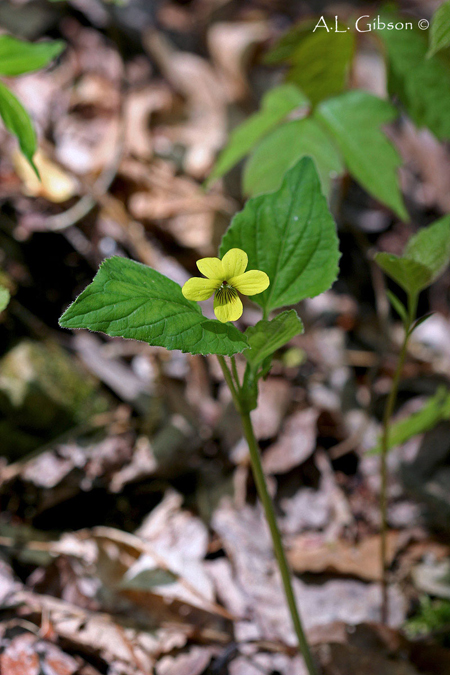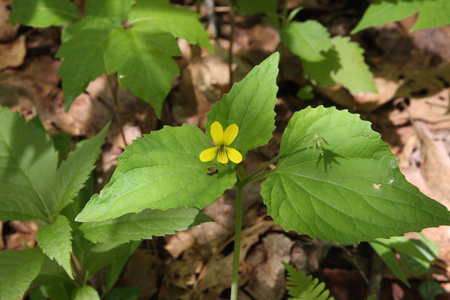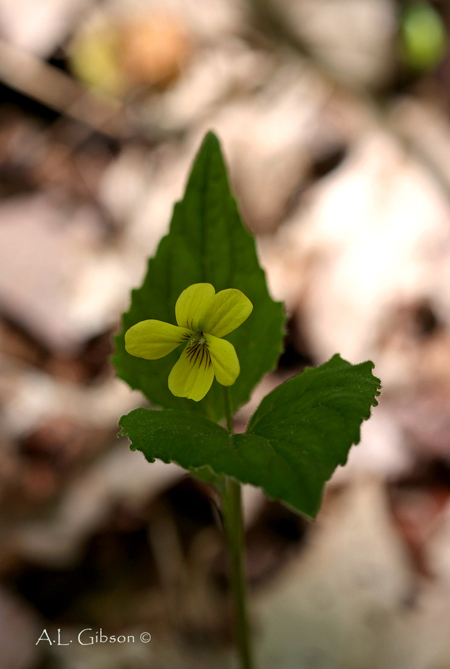Viola glaberrima (Ging. ex Chapm.) House
Common names:
Northern Wedge-leaved Violet
Synonyms:
Viola glaberrima (Ging.) House, Torreya 6: 172. 1906; Viola tripartita Elliott f. glaberrima (Ging.) H.Lév., Naturaliste Canad. 93: 501. 1966 [illegitimate homonym]; Viola tripartita Elliott f. glaberrima (Ging.) Fernald, Rhodora 51: 52. 1949; Viola tripartita Elliott var. glaberrima (Ging.) R.M.Harper, Bull. Torrey Bot. Club 27: 337. 1900; Viola hastata Michx. var. glaberrima Ging. ex Chapm., Fl. South. U.S., ed. 3: 34. 1897; Viola hastata Michx. var. glaberrima Ging., in DC., Prodr. 1: 300. 1824. TYPE: "In sylvis et collibus Carolinae septentrion." [Searches online, both in JSTOR Global Plants and in the online database of the Geneva Herbarium, have failed to yield specimens.]
Description:
Caulescent perennials from thick rhizome, stems erect, solitary, ≤ 36 cm tall; stem, foliage and peduncles green, glabrous or sparsely to moderately hirtellous with easily visible hairs; leaves cauline (rarely 1 basal), clustered in upper 1/4 of stems; stipules free, usually strongly erose; leaves spreading, leaf blades undivided, largest ≤ 92 × 90 mm, upper narrowly ovate-lanceolate, middle and lower narrowly ovate-triangular to broadly ovate-lanceolate, broadest well above the base, base cuneate to broadly rounded, margins conspicuously serrate to the tip, eciliate or appressed-ciliate, apex short- to long-acuminate; chasmogamous flower ≤ 14 mm; calyx glabrous or hirtellous along midvein, eciliate or ciliate; lowest sepals lanceolate, acute; auricles short and entire, not elongating in fruit; corolla wholly yellow with purple-black lines at base of petals and purple-tinged on backs of petals; spur short-globose; lateral petals densely bearded with slightly clavate hairs, spurred petal glabrous; cleistogamous flowers produced after chasmogamous; capsule 6–14 mm, green drying brown, unspotted, usually glabrous; seeds 2.7–2.8 × 1.8 mm, tan to light brown, unspotted.
Similar species:
In chasmogamous flower, this species might be confused with other caulescent yellow-flowered species with leaf blades longer than broad, such as occasional specimens of Viola eriocarpa and Viola hastata. It differs from Viola eriocarpa in its solitary stems with 1 or no basal leaves, cauline leaves clustered in the uppermost fourth of the plant, and cauline leaf blades with rounded to cuneate base; and from Viola hastata in leaf blades rhombic-ovate or ovate with a cuneate to rounded base and uniformly green upper leaf surface. In fruit, besides the above distinctions, it can be separated from Viola canadensis and Viola rugulosa by the fewer crenate-serrate teeth on the leaf blade margins, and the small herbaceous stipules. Its solitary stem with leaves clustered at the top, and entire stipules distinguish it from the caulescent rostrate violets often growing with it (V. labradorica, V. rostrata and V. striata).
Ecology:
Rich mesic to wet- mesic forests on lower slopes and bottomlands, especially over mafic or calcareous rocks.
Distribution:
Sw. PA to se. OH, south to w. & c. NC and e. KY (disjunct in n. GA).
Rarity:
State listed in OH, VA [as V. tripartita var. glaberrima]; PA and WV [as V. tripartita].
Phenology:
Chasmogamous flower March–May, chasmogamous fruit April–June, cleistogamous fruit July–August.
Affinities:
This species belongs to the Yellow Violet lineage, sect. Chamaemelanium Ging., in the Nudicaules species group.
Hybrids:
None.
Comments:
Brainerd (1921b), Russell (1965), Lévesque and Dansereau (1966), Gleason and Cronquist (1991), McKinney and Russell (2002), and Little and McKinney (2015) synonymized the present species under V. tripartita as a mere leaf morph. Fernald (1950) maintained it as V. tripartita f. glaberrima; Alexander (1963), Brainerd Baird (1942), Ballard (2000), and Weakley et al. (2012) recognized it as var. glaberrima. In all cases the present species has implicitly included V. tenuipes Pollard, a name forgotten as soon as it was published. Brainerd (1921b) reported visiting three southeastern localities, Biltmore Estate and Tryon, North Carolina, and Tuscaloosa, Alabama, where he found V. tripartita and V. glaberrima (including V. tenuipes) "often associated and intergrading", and used these observations as the basis for synonymizing all unlobed-leaved and lobed-leaved populations under V. tripartita. Russell (1965) mapped specimens with unlobed leaf blades and lobed or divided leaf blades, presenting a map with very few instances of county-level co-occurrence and a much broader, lower-elevation range for the unlobed-leaved populations, yet he argued that the two grow sympatrically and intergrade. Lévesque and Dansereau (1966) found no features to separate the taxa besides leaf dissection. Nevertheless, an as yet unpublished morphometric study of foliage and flower characteristics in the V. tripartita species complex by undergraduate researcher Nick Chilson and Ballard (2019) documented a number of statistically significant quantitative stem and leaf traits as well as other qualitative distinctions and tendencies in indument and leaves in addition to absolute differences in blade dissection, and a floral difference in nectarguide-lines, to separate V. glaberrima, V. tenuipes Pollard and V. tripartita (see traits used in the keys). Examinations of numerous collections from approximately 15 herbaria across the eastern U.S. revealed very few herbarium specimens with V. glaberrima (or V. tenuipes) taken from the same locality as V. tripartita, indicating a low frequency of local sympatry, and only a handful of sheets bore mixed collections to suggest (but not prove) co-occurrence. With several macromorphological distinctions and additional divergent tendencies among the three taxa in mind, no specimens displayed convincing evidence of "intergradation" or hybridization. Specimens from three locations in Georgia and Tennessee exhibited peculiar shallow leaf division that is intermediate between a deeply 3– or 5–lobed state and an entire leaf, but these were otherwise identical to typical V. tripartita sensu stricto in the area and appeared clearly to be a case of developmental arrest in leaf division, not hybridization with V. glaberrima (or V. tenuipes). An unpublished survey by Awl et al. (1996) of protected plant species on the Oak Ridge [National Laboratory] Reservation documented occurrences of V. glaberrima and V. tripartita on the tract but noted that the two taxa occupy different ecological niches and did not intergrade there. Our limited field observations corroborated comprehensive herbarium collections to indicate that this is the norm over the bulk of the range of the V. tripartita species complex, in which the three taxa grow in separate populations over the majority of their overlapping ranges, only rarely commingling, and the three taxa inhabit modally different ecological niches. This evidence overwhelmingly supports recognition of three distinct evolutionary species. The known northern extent of the range of V. glaberrima has been substantially expanded with recent herbarium collections and reidentifications of specimens previously attributed to V. eriocarpa or V. pubescens. Even as late as 1963, Alexander noted that it had not yet been reported (as var. glaberrima) from northeastern North America. Three violet complexes, V. glaberrima (sensu lato)/tripartita, V. brittoniana/pectinata, and the V. lobata complex in California and Oregon have been held up as examples of infraspecific leaf dimorphism. The V. tripartita species complex has clearly been misinterpreted. Our preliminary evidence on the V. brittoniana species complex indicates that the situation is also more complicated than simple allelic dimorphism can accommodate. A preliminary study by undergraduate researcher Tristan Kinnison on several herbarium collections for the V. lobata complex also reveals the presence of multiple distinct evolutionary taxa similar to the situation in the V. tripartita species complex. Current evidence would suggest that there are no legitimate instances of dimorphism in North American Viola except in corolla color of V. pedata, and that examples previously proposed as dimorphism were simply the consequence of inadequate empirical study.
Literature Cited:
Alexander, E. J. 1963. Violaceae. In Gleason, H. A., The new Britton and Brown illustrated flora of the northeastern United States and adjacent Canada. Hafner Publishing Co., Inc., New York, NY. 552-567.
Awl, D. J., L. R. Pounds, B. A. Rosensteel, A. L. King, and P. A. Hamlett. 1996. Survey of protected vascular plants on the Oak Ridge Reservation, Oak Ridge, Tennessee. Unpublished report, Environmental Restoration Division, Oak Ridge, TN.
Ballard Jr., H. E. 2000. Violaceae. In Rhoads, A. (ed.). Flora of Pennsylvania. University of Pennsylvania Press, Philadelphia, PA. 700-710.
Brainerd, E. 1921b. Violets of North America. Vermont Agricultural Experiment Station Bulletin 224: 1–172.
Brainerd Baird, V. 1942. Wild violets of North America. University of California Press, Berkeley, CA.
Chilson, N. and H. E. Ballard. 2019. Three from one: A taxonomic study of the Threepart Violet (Viola tripartita). Botany 2019, Tucson, AZ.
Fernald, M. L. 1950. Violaceae. In Gray’s Manual of Botany, 8th ed. American Book Company, New York, NY. 1022-1042.
Gleason, H. A. and A. Cronquist. 1991. Violaceae. In Manual of vascular plants of northeastern United States and adjacent Canada, 2nd ed. New York Botanical Garden, Bronx, NY. 157-163.
Lévesque, L., and P. Dansereau. 1966. Études sur les violettes jaunes caulescentes de l’Est de l’Amerique du Nord. I. Taxonomic, nomenclature, synonymie et bibliographie. Naturaliste Canadien (Quebec) 93: 489–569.
Little, R. J., and L. E. McKinney. 2015. Violaceae. In Flora of North America: Cucurbitaceae to Droseraceae, 106. Oxford University Press, New York, NY.
McKinney, L. E., and N. H. Russell. 2002. Violaceae of the southeastern United States. Castanea 67: 369–379.
Russell, N. H. 1965. Violets (Viola) of the central and eastern United States: An introductory survey. Sida 2: 1–113.
Strausbaugh, P. D. and E. L. Core. 1978. Violaceae. In Flora of West Virginia, 2nd ed. Seneca Books, Inc., Morgantown, WV. 644-658.
Weakley, A. S., J. C. Ludwig, and J. F. Townsend. 2012. Violaceae. In Flora of Virginia. BRIT Press, Fort Worth, TX. 963-975.

Chasmogamous flowering habit by Andrew Gibson, "Buckeye Botanist" website

Leaves during chamogamous flower by Bruce Sorrie

Chasmogamous flower front view by Andrew Gibson, "Buckeye Botanist" website

Chasmogamous fruit by Bonnie Isaac, from "iNaturalist" website

Map of Viola tripartita species complex by Harvey Ballard